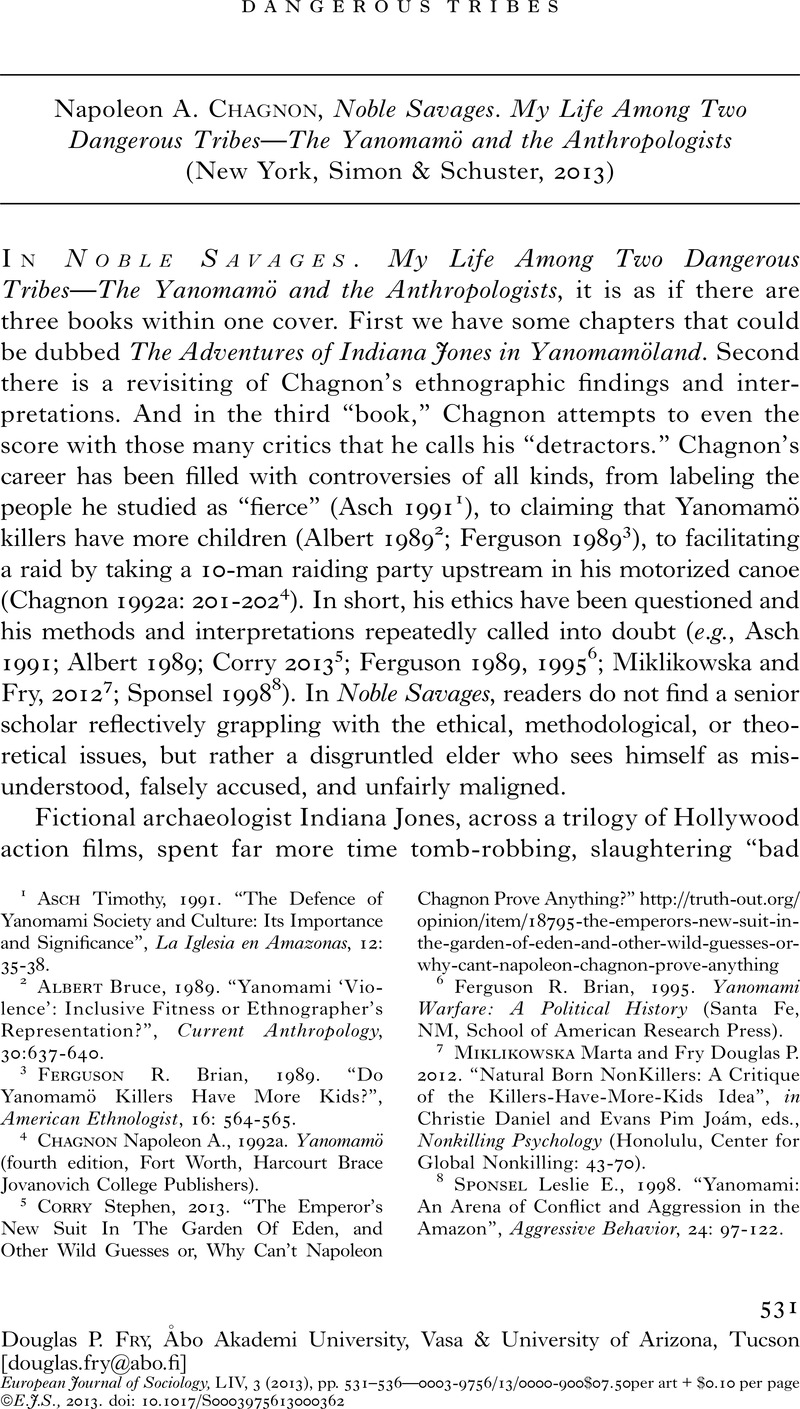No CrossRef data available.
Published online by Cambridge University Press: 22 January 2014

1 Asch Timothy, 1991. “The Defence of Yanomami Society and Culture: Its Importance and Significance”, La Iglesia en Amazonas, 12: 35-38.
2 Albert Bruce, 1989. “Yanomami ‘Violence’: Inclusive Fitness or Ethnographer’s Representation?”, Current Anthropology, 30:637-640.
3 Ferguson R. Brian, 1989. “Do Yanomamö Killers Have More Kids?”, American Ethnologist, 16: 564-565.
4 Chagnon Napoleon A., 1992a. Yanomamö (fourth edition, Fort Worth, Harcourt Brace Jovanovich College Publishers).
5 Corry Stephen, 2013. “The Emperor's New Suit In The Garden Of Eden, and Other Wild Guesses or, Why Can't Napoleon Chagnon Prove Anything?” http://truth-out.org/opinion/item/18795-the-emperors-new-suit-in-the-garden-of-eden-and-other-wild-guesses-or-why-cant-napoleon-chagnon-prove-anything
6 Ferguson R. Brian, 1995. Yanomami Warfare: A Political History (Santa Fe, NM, School of American Research Press).
7 Miklikowska Marta and Fry Douglas P. 2012. “Natural Born NonKillers: A Critique of the Killers-Have-More-Kids Idea”, in Christie Daniel and Evans Pim Joám, eds., Nonkilling Psychology (Honolulu, Center for Global Nonkilling: 43-70).
8 Sponsel Leslie E., 1998. “Yanomami: An Arena of Conflict and Aggression in the Amazon”, Aggressive Behavior, 24: 97-122.
9 Chagnon Napoleon A., 1990. “Reproductive and Somatic Conflicts of Interest in the Genesis of Violence and Warfare among Tribesmen” in Haas Jonathan, ed., The Anthropology of War (Cambridge, Cambridge University Press: 77-104).
10 Chagnon Napoleon A., 1992b. Yanomamö: The Last Days of Eden (San Diego, Harcourt Brace).
11 Fry Douglas P., 2006. The Human Potential for Peace: An Anthropological Challenge to Assumptions about War and Violence (New York, Oxford University Press).
12 Chagnon Napoleon A., 1988. “Life Histories, Blood Revenge, and Warfare in a Tribal Population”, Science, 239: 985-992.
13 Moore John H., 1990. “The Reproductive Success of Cheyenne War Chiefs: A Contrary Case to Chagnon’s Yanomamö”, Current Anthropology, 31: 322-330.
14 Beckerman Stephen, P. Erickson, J. Yost, J. Regalado, J. Jaramillo, L. Sparks, M. Iromenga, and K. Long, 2009. “Life Histories, Blood Revenge, and Reproductive Success among the Waorani of Ecuador”, Proceedings of the National Academy of Sciences, 106: 8134-8139.
15 Lizot Jacques, 1994. “On Warfare: An Answer to N. A. Chagnon (Translated by Sarah Dart)”, American Ethnologist, 21: 845-862.
16 Thoden Van Velzen H. U. E. and Van Wetering W., 1960. “Residence, Power Groups and Intrasocietal Aggression”, International Archives of Ethnography, 49: 169-200.
17 Otterbein Keith, 1970. The Evolution of War: A Cross-Cultural Study (New Haven, CT, HRAF Press).
18 Otterbein Keith, 2004. How War Began (College Station, TX, Texas A&M Press).
19 Fry Douglas P. and Söderberg, Patrik, 2013. “Lethal Aggression in Mobile Forager Bands and Implications for the Origins of War”, Science, 341: 270-273.
20 Knauft Bruce, 1991. “Violence and Sociality in Human Evolution”, Current Anthropology, 32: 391-428.
21 Tierney Patrick, 2000. Darkness in El Dorado: How Scientists and Journalists Devastated the Amazon (New York, W. W. Norton).
22 Kemp Graham and Douglas P. Fry, eds., 2004. Keeping the Peace: Conflict Resolution and Peaceful Societies around the World (New York, Routledge).